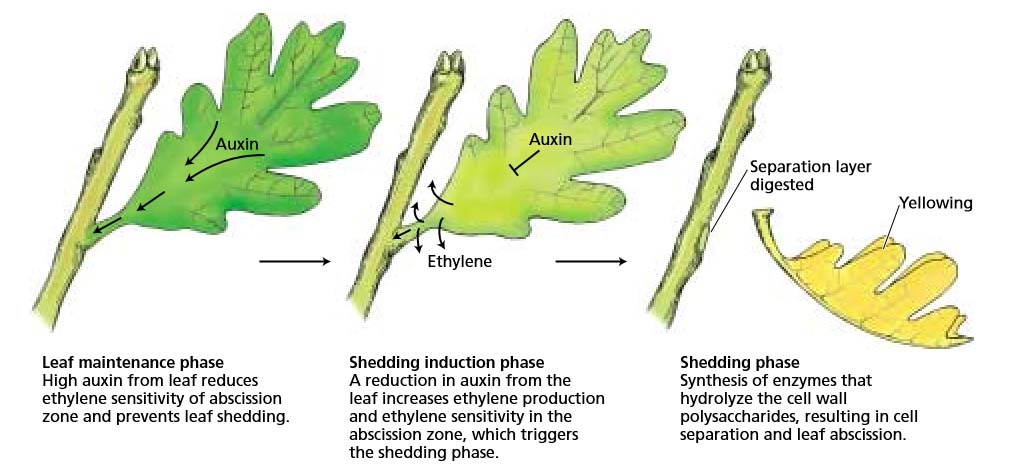During the 19th century, when coal gas was used for street illumination, it was observed that trees in the vicinity of streetlamps defoliated more extensively than other trees. Eventually it became apparent that coal gas and air pollutants affect plant growth and development, and ethylene was identified as the active component of coal gas.
Dimitry Neljubov (1901)
a graduate student at the Botanical Institute of St. Petersburg in Russia, observed that dark-grown pea seedlings growing in the laboratory exhibited symptoms that were later termed the triple response:
reduced stem elongation,
increased lateral growth (swelling),
and abnormal, horizontal growth.
When the plants were allowed to grow in fresh air, they regained their normal morphology and rate of growth. Neljubov identified ethylene, which was present in the laboratory air from coal gas, as the molecule causing the response.
H. H. Cousins (1910)
He reported that “emanations” from oranges stored in a chamber caused the premature ripening of bananas when these gases were passed through a chamber containing the fruit.
However, given that oranges synthesize relatively little ethylene compared to other fruits, such as apples, it is likely that the oranges used by Cousins were infected with the fungus Penicillium, which produces copious amounts of ethylene.
R. Gane and others (1934)
Identified ethylene chemically as a natural product of plant metabolism, and because of its dramatic effects on the plant it was classified as a hormone.
Roles of Ethylene
Ripening of Some Fruits
In everyday usage, the term fruit ripening refers to the changes in fruit that make it ready to eat.
Such changes typically include softening due to the enzymatic breakdown of the cell walls, starch hydrolysis, sugar accumulation, and the disappearance of organic acids and phenolic compounds, including tannins.
Ethylene has long been recognized as the hormone that accelerates the ripening of edible fruits. Exposure of such fruits to ethylene hastens the processes associated with ripening, and a dramatic increase in ethylene production accompanies the initiation of ripening.
However, surveys of a wide range of fruits have shown that not all of them respond to ethylene.
All fruits that ripen in response to ethylene exhibit a characteristic respiratory rise before the ripening phase called a climacteric. Apples, bananas, avocados, and tomatoes are examples of climacteric fruits.
In contrast, fruits such as citrus fruits and grapes do not exhibit the respiration and ethylene production rise and are called nonclimacteric fruits.
Epinasty
The downward curvature of leaves that occurs when the upper (adaxial) side of the petiole grows faster than the lower (abaxial) side is termed epinasty. Ethylene and high concentrations of auxin induce epinasty, and it has now been established that auxin acts indirectly by inducing ethylene production.
Seed and Bud Dormancy Breaker
Seeds that fail to germinate under normal conditions (water, oxygen, temperature suitable for growth) are said to be dormant.
Ethylene has the ability to break dormancy and initiate germination in certain seeds, such as cereals. In addition to its effect on dormancy, ethylene increases the rate of seed germination of several species
Ethylene can also break bud dormancy, and ethylene treatment is sometimes used to promote bud sprouting in potato and other tubers.
Elongation Growth of Submerged Aquatic Species
Although usually thought of as an inhibitor of stem elongation, ethylene is able to promote stem and petiole elongation in various submerged or partially submerged aquatic plants.
In these species, submergence induces rapid internode or petiole elongation, which allows the leaves or upper parts of the shoot to remain above water. Treatment with ethylene mimics the effects of submergence.
Formation of Roots and Root Hairs
Ethylene is capable of inducing adventitious root formation in leaves, stems, flower stems, and even other roots. Ethylene has also been shown to act as a positive regulator of root hair formation in several species.
Induces Flowering in the Pineapple
Although ethylene inhibits flowering in many species, it induces flowering in pineapple and its relatives, and it is used commercially in pineapple for synchronization of fruit set. Flowering of other species, such as mango, is also initiated by ethylene
Enhances the Rate of Leaf Senescence
Exogenous application of ethylene enhances the senescence and treatment with exogenous cytokinins delays leaf senescence
Auxins regulate the biosynthesis of ethyene in abscission zone
The shedding of leaves, fruits, flowers, and other plant organs is termed abscission. Abscission takes place in specific layers of cells, called abscission layers, which become morphologically and biochemically differentiated during organ development. Weakening of the cell walls at the abscission layer depends on cell wall–degrading enzymes such as cellulase and polygalacturonase.

Fig: Schematic view of the roles of auxin and ethylene during leaf abscission. In the shedding induction phase, the level of auxin decreases, and the level of ethylene increases. These changes in the hormonal balance increase the sensitivity of the target cells to ethylene. (After Morgan 1984.)